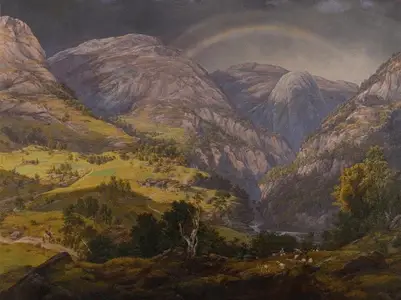Title of Artwork: “Stalheim”

Artwork by Johan Christian Dahl
Year Created 1824
Summary of Stalheim
The hilly landscape of Stalheim, Voss, Hordaland is depicted in an oil painting by J. C. Dahl titled View from Stalheim (Norwegian: Fra Stalheim) that was completed in 1842. As a major work of Romantic nationalism, it has achieved iconic status in the country. In the canon of Dahl’s works, this stands among the highest.
All About Stalheim
The picture depicts the late afternoon vista from the peak of Stalheim across the Naery Valley to the sugar-loaf shaped peak of Jordalsnuten, framed by peaks and a rainbow. The sun is shining on a small town in the middle. To paraphrase Dahl, he has created “a universe in small” in which distant people and structures are distinct. Both realism and depicting the beauty of the mountains and, by extension, his country’s culture, were important to him.
The painting’s grandiose allusions anticipate those of later American landscapes, such as Frederick Church’s Rainy Season in the Tropics (1866), which also features a rainbow at the painting’s peak. Both Joseph Anton Koch and Dahl’s friend and colleague Caspar David Friedrich commonly used rainbows into their work. Rainbows are a Christian emblem of God’s grace and peace.
The artwork by Dahl was started in 1836 and finished in 1842. Two pencil and watercolour studies he took in July 1826, on his first trip to Norway’s high mountain regions, served as the basis for this painting.
Both the composition and the details—such as the sunlight illuminating the village—are faithful to the studies, but Dahl has amplified the visual by shrinking the valley, so emphasising the Jordalsnuten mountain and downplaying the river’s emergence from the shadows.
When Dahl finished the painting, he swore off taking on any such projects of that scale again.
Countess Wedel of Bogstad commissioned the artwork. In 1914, Carl Gustav Wedel-Jarlsberg donated it to the Norwegian National Gallery.
The picture is considered to be among Dahl’s finest, and it may be the best example of his goal of presenting the mountains as both realistic and national symbols. It is now recognised all around the country. Even more than his other Norwegian landscapes, this one enticed visitors to the place, and in 1885 a luxurious hotel was constructed in Stalheim as a result.
Information Citations:
En.wikipedia.org, https://en.wikipedia.org/.
























